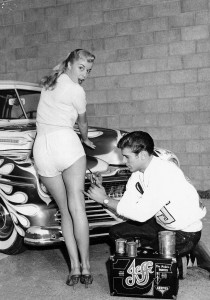Dean Jeffries: 50 Fabulous Years in Hot Rods, Racing and Film
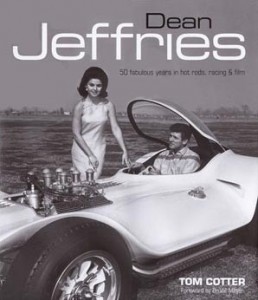 Dean Jeffries
Dean Jeffries
50 Fabulous Years in Hot Rods, Racing and Film
By Tom Cotter
This new book on Dean Jeffries, written by Tom Cotter (and forwarded by Bruce Meyer) is a fun look at the career of one of the most under-rated builders of all-time. As stated right from the beginning, Jeffries was never one to “toot his own horn”, and this may be a large part of the reason that many folks don’t know that much about this incredibly talented man. While he was one of the pioneers of the custom car movement (alongside the more “celebrity” names like Barris, Winfield, Von Dutch and Ed Roth), he’s always been relegated to the footnotes, or seems to play the “behind-the-scenes” role more often than not.
The humble visionary was born in Lynwood, California in 1933, the second of three children, and from an early age took an interest in cars… but preferred metal work to mechanical, as he hated to get his hands dirty. His father being a mechanic and truck driver who wrenched on race cars (midgets, namely), took young Dean to the races, further inspiring him.
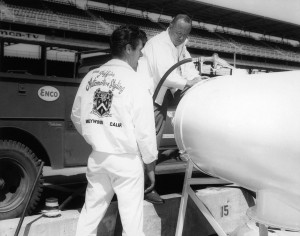 Jeffries left school early to join the Army, and served during the Korean War, but was stationed in Germany, where he served duty as a map maker, and began pinstriping. Upon returning home, he worked nights in a machine shop to spend his days as an apprentice under Ken “Von Dutch” Howard. Eventually Jeffries became the “house striper” at Barris Kustom, honing his metalworking skills, and becoming a contractor to Barris, and plied his craft on such cars as the Ala Kart, Clarence Catallo’s ’32 Ford (the very same from the Beach Boys’ Little Deuce Coupe album cover).
Jeffries left school early to join the Army, and served during the Korean War, but was stationed in Germany, where he served duty as a map maker, and began pinstriping. Upon returning home, he worked nights in a machine shop to spend his days as an apprentice under Ken “Von Dutch” Howard. Eventually Jeffries became the “house striper” at Barris Kustom, honing his metalworking skills, and becoming a contractor to Barris, and plied his craft on such cars as the Ala Kart, Clarence Catallo’s ’32 Ford (the very same from the Beach Boys’ Little Deuce Coupe album cover).
Moving from Barris’ shop to Hollywood, Jeffries was in a prime location to serve movie stars, and began building specialty vehicles for the motion picture industry.
The book delves into the well-known Jeffries-Barris rivalry, offering insight to those who may not have been initiated to this historic debate. What’s truly interesting about this small part of the book is that Cotter not only gives Jeffries’ side, but takes time to talk with Barris as well, making for an entertaining aside.
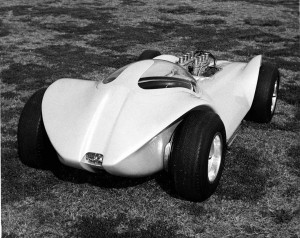 As the book moves forward, we gain extensive insight to Jeffries’ personal life, detailing his long marriage to his late wife Row, underscoring her importance to him in many ways, and being the driving force behind his never-ending creativity. We’re treated to an extensive look at his creations, including some absolutely incredible photos from Jeffries’ personal collection, as well as those collected from sources close to him.
As the book moves forward, we gain extensive insight to Jeffries’ personal life, detailing his long marriage to his late wife Row, underscoring her importance to him in many ways, and being the driving force behind his never-ending creativity. We’re treated to an extensive look at his creations, including some absolutely incredible photos from Jeffries’ personal collection, as well as those collected from sources close to him.
From the aluminum masterpiece “Mantaray” to the Kyote dune buggies, we’re treated to some wildly insightful looks at the creative process, as well as Dean’s great business mind. Moving forward to his work on the Ford Custom Car Caravan (and his ahead-of-its-time Falcon Python), to the supremely well-designed Deano Toronado, we begin to see the scale of his creative genius.
There is some tremendous coverage and in-progress photography of his many movie and television cars, including the Green Hornet’s Black Beauty, the Monkeemobile, and the absolutely immense Landmaster for the film Damnation Alley (looking over Jeffries’ designs and engineering thought for this project is almost worth the price of admission alone). Being a creative, yet practical customizer, Jeffries built a mobile shop from a van to handle on-set repairs for movie cars, and we get a glimpse of what was, at the time a state-of-the-art rolling repair shop.
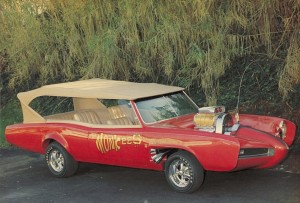 Following some mini-features on many of Dean’s creations over the years, the book hooks a big turn to his involvement in motorsports, painting cars for the Indy 500, and even includes some of his designs for an Indy car from the early 1960’s.
Following some mini-features on many of Dean’s creations over the years, the book hooks a big turn to his involvement in motorsports, painting cars for the Indy 500, and even includes some of his designs for an Indy car from the early 1960’s.
If all of that weren’t enough, we learn about Jeffries’ work as a stuntman, performing feats that today would be deemed as too unsafe, and on one notable occasion while jumping a bridge with a truck, he broke his back. Some fantastic photos accompany this part of the book, and they go well beyond the typical studio PR shots, keeping with the book’s “personal” feel.
Overall, a very well presented book, loaded with rare photos and insight, and one of those “must-have’s” for any fan of hot rods and custom cars. It has that fabulous, high-quality Motorbooks feel with sharp photos, just the right size text, and thick pages with just enough sheen to look great, but not glare when reading. Truly a great addition to any collection, and it’ll even look bitchin’ on your coffee table!
–Brian Stupski, Problem Child Kustoms


